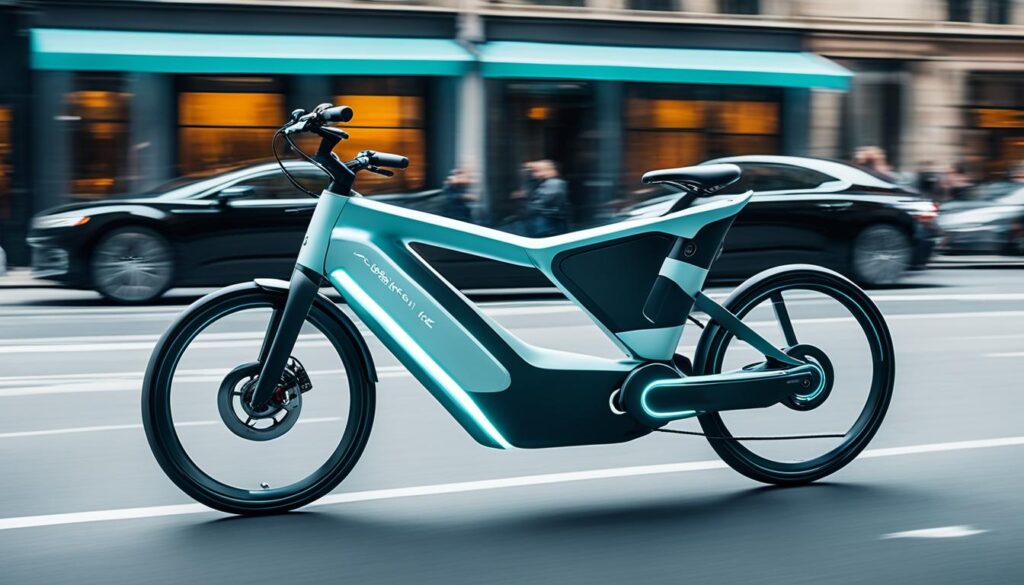Electric bikes mix traditional cycling with the bonus of motorized help. They are great for people who care about the environment or want a little extra power. Wondering about the weight? Electric bikes are heavier than regular bikes, weighing between 30 to 80 pounds. This is because of their motor and battery. These parts add to the bike’s weight but offer you an extra push.
E-bikes are getting more popular. So, it’s important to know about their weight. The weight affects how the bike feels and how you control it. E-bikes vary in weight because of their batteries, motors, and frames. This changes how each bike rides.
Key Takeaways
- Electric bike weight, or e-bike weight, is a pivotal factor affecting a bike’s handling and performance.
- Average e-bike weight ranges from 30 to 80 pounds, influenced by electric bicycle weight components like the motor and battery.
- Heavier e-bikes may require more power to maintain speed, impacting the overall range and efficiency.
- Understanding the factors contributing to e-bike weight can help potential buyers make informed decisions tailored to their needs.
- The knowledge of how much electric bikes weigh can guide users in managing their expectations on ride comfort and performance.
What Influences the Weight of an Electric Bike
Understanding the factors that affect an electric bike’s weight is crucial when buying one. The weight influences how the bike performs, how easy it is to carry, and its functionality.
The Role of Batteries and Electric Motors
The battery is key in determining an e-bike’s weight. Batteries range from 2 to 3.5 kg, based on power capacity. Heavier batteries offer more range but add weight. Motors also affect weight, typically weighing 4-5 kg. They power the bike and add to the total mass.
Frame Materials and Construction
The frame’s weight heavily impacts an e-bike. Made from aluminum or carbon, frames aim to be strong yet light. Aluminum is durable and less expensive, whereas carbon is lighter but pricier. The frame influences the bike’s weight, strength, and ride quality.
Additional Components: Wheels, Handlebars, and Controller
Wheels, handlebars, and controllers also add weight. For example, fat tire e-bikes have heavier wheels. Off-road bikes need stronger handlebars. Advanced controllers for the electric system increase weight too. All these parts enhance the bike’s use.
Road e-bikes weigh around 40 pounds (18 kg), which is lighter than mountain e-bikes. Mountain e-bikes weigh between 40 and 70 pounds (18-32 kg). This shows how different parts affect the weight. The 145% increase in e-bike sales from 2019 to 2020 in the U.S. highlights the importance of knowing about e-bike weight.
The Impact of Electric Bike Weight on Performance
Electric bike weight is key to how well it performs. Things like speed and how easily you can steer are influenced by it. Understanding the effects of weight on e-bikes is crucial for the best ride.
How Weight Affects Speed and Maneuverability
An electric bike’s weight really matters for its speed and ease of movement. Heavier e-bikes feel stable but lack quickness and agility. Studies show battery weight affects top speed too. Riders in cities need to easily dodge traffic and take tight corners. A heavier bike also uses more power to keep up speed, lowering its efficiency.
Handling Differences Between Lighter and Heavier E-Bikes
Lighter e-bikes handle better than heavy ones, especially in crowded places or on trails. The battery’s weight and where it sits can change how the bike feels. For example, batteries in the middle make the bike steadier. This idea is key to Tritek’s battery design, aiming for the best performance and handling.
Weight Considerations for Different Riding Conditions
The type of terrain greatly influences the ideal bike weight. For fun rides or mountain biking, go light for easy climbs and going over rocks. However, in the city, a heavier e-bike might be better for carrying stuff and dealing with busy streets. Colorado’s laws now recognize the importance of e-bike weight for various outdoor activities. This helps people choose the right bike for their needs.
In summary, weight plays a huge role in enjoying your e-bike ride. It affects everything from handling to speed and how much power it uses. Think about these points and how you plan to use the bike to pick the best one for you.
Comparing Electric Bike to Traditional Bicycle Weights
Electric bikes are heavier than traditional bicycles. This is because they have battery packs and motors. A regular bike can weigh as little as 11 pounds. But an electric bike’s weight starts at 30 pounds and can go up to 80 pounds.
The weight of an e-bike adds up from different heavy parts. Batteries can weigh between 10 to 20 pounds. Motors add 4.4 to 11 pounds. Then you have the frame. Sturdier models can weigh up to 73 pounds. This makes e-bikes built for endurance, not for being light.
Racing e-bikes are the lightest electric models, weighing around 40 pounds. Fat tire e-bikes for off-roading can weigh between 60 and 80 pounds. Here’s how different types of e-bikes compare:
| Type of E-Bike | Weight Range (pounds) | Special Feature |
|---|---|---|
| Folding Electric Bikes (General) | 30-70 | Portability |
| Mini Folding E-Bikes | 30-40 | Ultra-compact |
| Commuting E-Bikes | 50-70 | Extended battery life |
| Mountain E-Bikes | 40-70 | Off-road capability |
| Cruiser E-Bikes | ~70 | Comfort features |
| Fat Tire E-Bikes | 60-80 | All-terrain adaptability |
| Comfort E-Bikes | 50-70 | Ergonomic design |
The big weight difference between e-bikes and regular bikes can change your cycling experience. It can particularly affect how you move and handle the bike. But, this also shows a trade-off. You get the ease of electric power at the cost of simplicity.
Deciding if an e-bike’s extra weight is a downside depends on what you need. For long trips, a heavier e-bike can be a dependable choice. Yet, for day-to-day use, a lighter e-bike that’s easy to handle might be better.
The Average Weight Range of Popular Electric Bike Models
Electric bikes (e-bikes) have become a hit with city riders and outdoor fans. Knowing the average weight of electric bikes is key for anyone thinking of getting one. The popular e-bike models weight varies because of things like frame materials and the size of the motor and battery. With more people choosing eco-friendly transport, e-bikes now have to follow certain laws and rules. This impacts how they’re made and how much they weigh.
Ride1Up’s Electric Commuter Bikes
The Ride1Up e-bike weight varies from 33 to 65 pounds, blending efficiency with comfort for everyday riding. These bikes show how versatile e-bikes can be. They meet the legal bike requirements in many U.S. states without needing a special license to ride. Ride1Up’s bikes usually are Class 3 e-bikes. They offer pedal help up to 28 mph, perfect for fast and dependable city travel.
Fat Tire and Mountain E-Bikes: Why They Tend to Be Heavier
The fat tire e-bike weight and mountain e-bike weight are on the heavy side, often weighing between 60 to 80 pounds. These bikes are made for tough ground. They come with stronger motors and more solid frames. Fat tire bikes need extra weight for better balance on rough terrain. Both types usually are in Class 2 and Class 3 e-bike groups.
The Rarity of Ultra-Lightweight Electric Bikes
Lighter bikes are easier to handle and quicker, but ultra-lightweight e-bike rarity shows how hard it is to make them. Even with new materials like carbon fiber, creating light bikes with strong batteries and motors is a big challenge. For now, super light e-bikes are rare finds.
| E-Bike Type | Average Weight | Class | Features |
|---|---|---|---|
| Ride1Up Commuter | 33-65 lbs | Class 3 | Pedal assist up to 28 mph, urban convenience |
| Fat Tire E-Bike | 60-80 lbs | Class 2 | Built for off-road, more powerful motor |
| Mountain E-Bike | 60-80 lbs | Class 1 | Downhill riding, high torque motors |
| Ultra-Lightweight E-Bike | Varies | N/A | Rarity due to design and technology constraints |
In the end, e-bikes give more people a chance to enjoy biking, but the weight is something to think about. Whether you’re riding to work or on an adventure, there’s an e-bike that’s just right for you. As designs get better, we’ll see more kinds of e-bikes. They’ll match up with what riders want in an eco-friendly and custom way.
Conclusion
At the end of our journey into the e-bike world, we’ve seen a lot of innovation. E-bike weight comes from the battery, motor, frame, and parts. These elements affect how the bike moves and performs. E-bikes are heavier than regular bikes. But, they offer more power and can go farther. They are chosen by riders everywhere, from Colorado’s mountains to the Netherlands’ paths. E-bikes lead us toward a more eco-friendly future.
E-bike weight matters, but let’s also look at the numbers. In Europe, more people are buying e-bikes for far commutes and a fit lifestyle. Dutch riders go 50% farther on an e-bike. Despite higher costs and tariffs, e-bike use keeps growing. Their health benefits are similar to regular cycling. This shows us e-bikes can change how we stay fit and move around cities.
E-bikes open new doors, no matter their weight. They mix fun and practicality, push us to be more active, and help the planet. Every e-bike model is made for different people. There’s an e-bike for thrill-seekers and for those who commute. This means there’s an electric bike perfect for you, whatever your needs.



